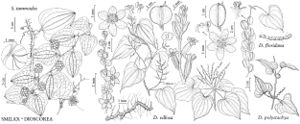Difference between revisions of "Dioscorea floridana"
U.S.D.A. Bur. Pl. Industr. Bull. 189: 18. 1910.
FNA>Volume Importer |
FNA>Volume Importer |
(No difference)
| |
Revision as of 21:38, 16 December 2019
Plants rhizomatous; rhizomes yellow, unbranched, horizontal, 0.5–1 cm or more diam., nodes articulate, each segment bearing 1 dark, contrasting, ± deltate scale leaf, scales brown and papery, caducous, each leaving dark, linear scar perpendicular to growing axis. Stems twining counterclockwise, ± polygonal to terete, 1–4 m, surface longitudinally grooved. Leaves alternate proximally (variation expected) and distally, 3–11 × 3–9 cm; petiole 3–8 cm, base not clasping; blade sometimes glandular, 7–9-veined, ovate-cordate to deltate, glabrous, margins entire or repand, apex acuminate. Staminate inflorescences (1–)2–5 in leaf axils, terminal, spicate to highly branched; cymes sessile, bearing 1–3 sessile flowers, bracteolate, internodes between cymes 2–5 mm, bracteoles linear-lanceolate, ca. 1 mm; rachis to 30 cm, secondary axes to 15 cm, subtended by linear-lanceolate bracts ca. 1–2 mm. Pistillate inflorescences borne singly, 4–20 or more-flowered, 4–25 cm, internodes 7–12 mm. Staminate flowers: perianth yellowish orange, rotate-campanulate to funnelform, 1–2 mm; tepals ± glandular, oblong, margins hyaline, apex (acute to) rounded or truncate; stamens in 2 equal whorls, inwardly curved; anthers ca. 1/3 length of filaments, thecae connate. Pistillate flowers: perianth as in staminate flowers; staminodes 6, differentiated into anthers and filaments, less than 1/2 size of fertile stamens. Capsules greenish gold, ovoid, obreniform, or oblong, 1.5–2.8 × 1.5–2.5 cm. Seeds 9–13 mm.
Phenology: Flowering late spring–mid summer; fruiting late summer.
Habitat: Edges of swamps, in hammocks, moist and dry (pine) forests and forest margins, sandy soils, lowlands
Elevation: 0–100 m
Distribution

Fla., Ga., S.C.
Discussion
Dioscorea floridana is undoubtedly a close relative of D. villosa, but because it is identifiable using characters that vary discretely, with states not manifest in plants occupying similar habitats outside of its range, I have chosen to retain it at the rank of species.
Selected References
None.
